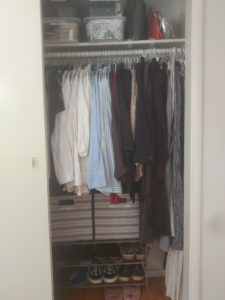Life is tough enough! Easily finding something clean to wear that you love shouldn’t be! Want to do something really good for yourself now that you’ve survived another tax year? Here are three easy clutter-busting activities that won’t tax you and may end up saving you time and money!
Organize your laundry
Take five minutes and sort that giant pile of overflowing laundry into four stacks:
- Whites including white sheets and white towels
- Bright colors such as pink, red, purple, yellow, orange or light blue or washable delicates including anything that has never been washed before,
- Dark colors including black, grey, navy or brown.
- Heavy items such as blankets.
Contain three of the piles into a laundry sorter, bins or baskets and load the remaining pile in the laundry. While the first load is washing you can now attend to your clothes.
Organize your clothing drawers
Start by choosing the most overstuffed drawer in your dresser. Empty the contents into a pile on your bed, assuming it’s clear. If it’s covered in clothing include these too. If it’s covered in other items, remove them to a nearby table. You want to start with a clear surface.
- Start sorting items like with like. For example: Long sleeve shirts, t-shirts (single color) graphic t-shirts, sleeveless shirts, knit shirts, button down shirts, etc. If you have items you would never wear but have strong memories or sentimental value, put those in their own pile.
- Once sorted, go through each pile, item by item and purge all items you don’t love, have not worn in over a year, are ripped, stained or would require too much work to restore – DO YOU REALLY WANT TO SPEND YOUR PRECIOUS TIME GETTING A STAIN OUT OF AN OLD T-SHIRT? Put the discarded items in a black trash bag. If you have great quality items you don’t want and still have tags on them, put those in a separate bag labeled “To Sell.” For sentimental items, take a picture of them and let them go or if you must, store them in a bin at the top of your closet with a label that reads: Stored on _____ date.
- Check to see if your first load of laundry is ready for the dryer and put the next load in and return to your pile of clothes.
- You should now have several piles of clothing you do want. If the drawer you emptied these from is large enough to contain them, without stuffing them in, begin folding or rolling them. I like the folding in thirds method so that items can be terraced together inside your drawer. Any button down blouses or shirts should hang in your closet.
- Place folded items inside your drawer, by type and if you like by color. You’ll love the way they look and it will be so easy to find what you need!
- Now go back, and check your laundry. Remove the first load from the dryer fill the second load. Fold your dry clothing however you are used to or use the folding in thirds method included above.
Organize your hanging clothing
- As above, remove all hanging items from your closet. Include, clothing, scarves, belts, and handbags.
- If you have a sturdy portable clothing rack, place the items on the rack. Otherwise use your bed to sort by color and type.
- Again, sort items like with like. For example. Long hang dresses/skirts, pants, jackets, long sleeve blouses, short sleeve blouses, better quality camisoles, large purses, small purses, small clutches, bags, belts and scarves. Resist the urge to purge things at this stage as you may end up tossing something you intended to keep. It’s also much easier to make a decision about what to edit when you are looking at “like” items.
- One by one, purge items as described above. Set aside clothing you prefer to gift to others just don’t contribute to their clutter as a tactic for holding on to things!
- Once edited, replace items hanging on wood hangers, cheap store hangers or slippery plastic hangers that take up a lot of real estate in your closet with non-slip, space saving hangers available at many stores.
- Store handbags in bins or on upper shelves. Use area below short hanging items for shoes. Space permitting, use bins to store heavier weight sweaters and scarves (as pictured). I recommend using labels for bins, even if they are translucent, to remind you and others what they do and don’t contain.

- Finally, return to your laundry to add in your final load in the washer and dryer. Remove folded clothes and return them to their rightful owner. If they are yours, you can now neatly return them to your newly organized drawer and closet.
Now, sit back and admire your work! Tomorrow getting dressed will be a whole lot easier and definitely less stressful than your taxes!









